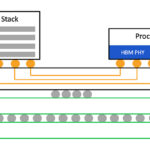 Microchip Technology announced its RTG4 Field Programmable Gate Array (FPGA) family is the first in a Ceramic Quad Flat Pack (CQFP) option to achieve qualification to the industry’s Qualified Manufacturers List (QML). The achievement will enable space system developers to create systems using more reliable packages that simplify the layout and routing of Printed Circuit Boards (PCBs) that are also easier to assemble and inspect.
Microchip Technology announced its RTG4 Field Programmable Gate Array (FPGA) family is the first in a Ceramic Quad Flat Pack (CQFP) option to achieve qualification to the industry’s Qualified Manufacturers List (QML). The achievement will enable space system developers to create systems using more reliable packages that simplify the layout and routing of Printed Circuit Boards (PCBs) that are also easier to assemble and inspect.Microchip’s CQFP package with 352 pins for RTG4 FPGAs simplifies system design in applications ranging from satellites and space probes to planet landers and vehicles. The CQFP package option is easier to assemble than Ceramic Column Grid Array packages, further improving reliability while enabling a more cost-effective system integration alternative to higher-pin-count alternatives. It is ideal for control applications that do not require a high number of inputs/outputs (I/Os) or need frequent switching and a high number of temperature cycles.
RTG4 FPGAs give space systems new high-speed signal-processing capabilities and leverage reprogrammable flash memory to provide greater immunity to configuration Single Event Upsets (SEUs) while consuming 40 to 50 percent less power than competing Static Random Access Memory (SRAM) FPGAs. RTG4 FPGAs feature 150,000 Logic Elements (LEs), 462 multipliers, and 5.2 megabits (Mb) of memory. With this qualification, Microchip is now able to offer a full range of qualification and screening options for RTG4 FPGAs in the CQFP package suitable for a wide range of space missions from class 1 applications that require QML-V components, to low-cost New Space constellations with relaxed screening requirements.






Leave a Reply